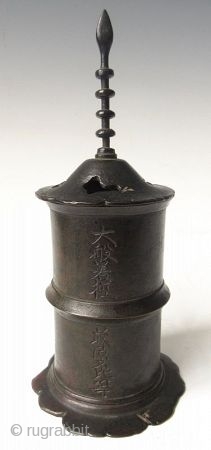Back
Antique Japanese Bronze Sutra Container
Antique Japanese bronze sutra container of a pagoda form with very tall finial and calligraphy inscription. The bronze shows beautiful green patina inside and on the foot and the lid shows old corrosion. The burial of sutras in sutra mounds began in 1007 when Fujiwara no Michinaga had a gilt bronze sutra container inscribed upon its burial at the Kinpusen sutra mound in Yoshino. It is apparent that a variety of reasons lay behind the creation of these sutra mounds. Clearly these mounds were primarily an effort to preserve the sutras expounding the teachings of the Buddha through the millennia of the age of the last law, or Mappo, that was said to be going to continue until the rebirth of Miroku (Maitreya) would provide salvation for humanity. The sutra mounds were intended to promulgate and protect these sutras, and the majority of these were based on stupas, and hence were diverse in shape. These sutras which preserved the teachings or remains of the first Buddha were thus equated with the Buddhist relics which were preserved in Buddhist stupas.
The upper 4 characters 大般若経 read : Daihan'nya-kyō The lower 5 characters 藤原不比等 read : Fujiwara no Fuhito
大般若経 (Daihan'nya-kyō) is an abbreviated form of 大般若波羅蜜多経 (Daihan'nyaharamitta-kyō), the full name of the Mahāprajñāpāramitā Sūtra, or Heart Sutra, in Japanese. (Dai is a translation of Sanskrit mahā; han'nya is a transliteration of Sanskrit prajñā; haramitta / pāramitā is elided here; and kyō is a translation of sutra) 藤原不比等 is a person's name: Fujiwara no Fuhito
Early Edo or older c1600
Dimensions: 3 1/2" w x 7 3/4" h
Antique Japanese bronze sutra container of a pagoda form with very tall finial and calligraphy inscription. The bronze shows beautiful green patina inside and on the foot and the lid shows old corrosion. The burial of sutras in sutra mounds began in 1007 when Fujiwara no Michinaga had a gilt bronze sutra container inscribed upon its burial at the Kinpusen sutra mound in Yoshino. It is apparent that a variety of reasons lay behind the creation of these sutra mounds. Clearly these mounds were primarily an effort to preserve the sutras expounding the teachings of the Buddha through the millennia of the age of the last law, or Mappo, that was said to be going to continue until the rebirth of Miroku (Maitreya) would provide salvation for humanity. The sutra mounds were intended to promulgate and protect these sutras, and the majority of these were based on stupas, and hence were diverse in shape. These sutras which preserved the teachings or remains of the first Buddha were thus equated with the Buddhist relics which were preserved in Buddhist stupas.
The upper 4 characters 大般若経 read : Daihan'nya-kyō The lower 5 characters 藤原不比等 read : Fujiwara no Fuhito
大般若経 (Daihan'nya-kyō) is an abbreviated form of 大般若波羅蜜多経 (Daihan'nyaharamitta-kyō), the full name of the Mahāprajñāpāramitā Sūtra, or Heart Sutra, in Japanese. (Dai is a translation of Sanskrit mahā; han'nya is a transliteration of Sanskrit prajñā; haramitta / pāramitā is elided here; and kyō is a translation of sutra) 藤原不比等 is a person's name: Fujiwara no Fuhito
Early Edo or older c1600
Dimensions: 3 1/2" w x 7 3/4" h
price:
6000.00
- Home
- Antique Rugs by Region
- Category
- Profiles
- Post Items Free
- Albums
- Benaki Museum of Islamic Art
- Budapest: Ottoman Carpets
- Gulbenkian Museum
- Islamic Carpets. Brooklyn
- Islamic Textiles. Brooklyn
- Konya Museum: Rugs
- MKG, Hamburg
- MMA: Caucasian Carpets
- MMA: Mamluk Carpets
- MMA: Mughal Indian Carpets
- MMA: Ottoman Carpets
- MMA: Safavid Persian Carpets
- MMA: Turkmen Rugs
- McCoy Jones Kilims
- Ottoman textiles. Met
- Philadelphia Museum
- Rugs and Carpets: Berlin
- Seljuqs at the Met
- TIEM, Istanbul: Carpets
- V&A: Classical Carpets
- Vakiflar Carpets: Istanbul
- Baluch Rugs: Indianapolis
- Gallery Exhibitions
- Jaf an Exhibition
- Alberto Levi Gallery
- Andean Textile
- Christie's London: 2016
- Francesca Galloway
- HALI at 40
- ICOC Washington, DC 2018
- Jajims of the Shahsavan
- London Islamic Week April, 2018
- Mongolian Felts
- Navajo Rugs: JB Moore
- Persian Piled Weavings
- SF Tribal & Textile Art Show 2020
- SF Tribal 2019
- Sotheby's: C. Alexander
- Turkish Prayer Rugs
- Turkmen Main Carpets ICOC 2007














